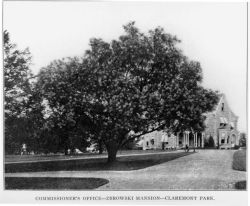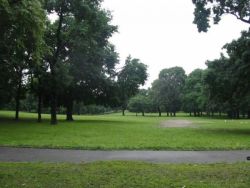Claremont Park
Zborowski Point
This spot was originally the site of the Claremont Mansion, home of Elliott and Anna Zborowski de Montsaulain. Claremont Park was originally part of the Morris family estate, founded in 1679. Aware of encroaching suburban development with the arrival of the New York and Harlem River Railroad, Gouverneur Morris II (1813-1888) auctioned off much of his land in 1848. Newlyweds Elliott Zborowski de Montsaulain and Anna Bathgate acquired a parcel in the northern portion of the former Morris property. In 1859, they built the Claremont Mansion, renowned for its white marble sculptural decor, and developed the 38 acre grounds with terraced lawns that descended to the Mill Brook (now Webster Avenue).
In 1881, John Mullaly, regarded as the father of the Bronx parks system, helped to found the New York Park Association. Presenting comparative studies of parkland in foreign cities, predictions of rapid population growth in New York, and rising land values, the association called for more parkland in the southern Bronx, which New York City annexed in 1874. This effort culminated in the 1884 New Parks Act and the city’s 1888-90 purchase of land for Claremont, Crotona, Van Cortlandt, Bronx, St. Mary’s, and Pelham Bay Parks and the Mosholu, Bronx and Pelham, and Crotona Parkways.
When the Claremont property became a park, the mansion was converted for use as the local administrative headquarters of the Bronx Parks Department. Substantial changes in the 1930s and 1940s transformed Claremont into a modern park. The Claremont Mansion was razed in 1938 and replaced with a gazebo. Bronx Parks headquarters moved to a new building, named Ranaqua, on Bronx River Parkway.
Today this gazebo is a favorite spot for many local events. Easy to decorate and close to park comfort facilities, benches, and lawns, Zborowski Point is an especially popular location for children’s birthday parties. The park’s name is also reminiscent of a famous scenic overlook in Death Valley National Park in California that was featured in the eponymous 1969 movie Zabriskie Point by Michelangelo Antonioni.
Check out your park's Vital Signs
Clean & Safe
Green & Resilient
Empowered & Engaged Users
Share your feedback or learn more about how this park is part of a
Vital Park System










